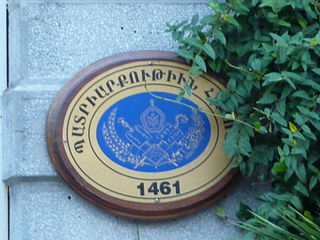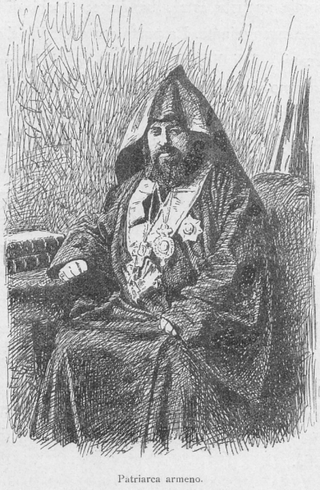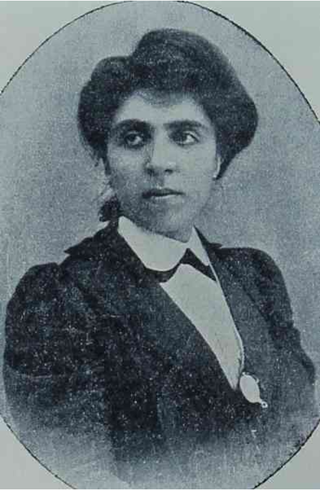
Yeghia Dndesian (born Istanbul, Ottoman Turkey 1834 - died Constantinople, Ottoman Turkey 1881) was an Armenian musician and musical reformer. [1]

Yeghia Dndesian (born Istanbul, Ottoman Turkey 1834 - died Constantinople, Ottoman Turkey 1881) was an Armenian musician and musical reformer. [1]
Yeghia Dndesian was among the cultivators of the Sharagan musical style and notation used throughout Armenian churches and religious services. [1] He was instrumental in resurfacing much of the lost information of ancient Armenian music. In April 1873, a committee consisting of priests, clergymen, and scribes arrived in Constantinople to gather, revise, or recompose Sharagan melodies in order to preserve them for notation. [2] Dndesian was chosen as a member of the committee along with Nigoghos Tashjian, and Aristakes Hovannesian (1812-1878). [1] After putting much work, Dndesian eventually published a five volume book in 1871 entitled Sharagan Tzainakryal or Sharagan Notations. [1]

The Avedis Zildjian Company, simply known as Zildjian, is a musical instrument manufacturer specializing in cymbals and other percussion instruments. Founded by the ethnic Armenian Zildjian family in the 17th-century Ottoman Empire, the company relocated to the United States in the 20th century. Today, it is the largest cymbal and drumstick maker in the world.

Üsküdar is a municipality and district of Istanbul Province, Turkey. Its area is 35 km2, and its population is 524,452 (2022). It is a large and densely populated district on the Anatolian (Asian) shore of the Bosphorus. It is bordered to the north by Beykoz, to the east by Ümraniye, to the southeast by Ataşehir and to the south by Kadıköy; with Karaköy, Kabataş, Beşiktaş, and the historic city center of Fatih facing it on the opposite shore to the west. Üsküdar has been a conservative cultural center of the Anatolian side of Istanbul since Ottoman times with its numerous historic landmark and little mosques and dergahs.

Soghomon Soghomonian, ordained and commonly known as Komitas, was an Ottoman-Armenian priest, musicologist, composer, arranger, singer, and choirmaster, who is considered the founder of the Armenian national school of music. He is recognized as one of the pioneers of ethnomusicology.

The Social Democrat Hunchakian Party (SDHP), is the oldest continuously-operating Armenian political party, founded in 1887 by a group of students in Geneva, Switzerland. It was the first socialist party to operate in the Ottoman Empire and in Iran, then known as Persia. Among its founders were Avetis Nazarbekian, Mariam Vardanian, Gevorg Gharadjian, Ruben Khan-Azat, Christopher Ohanian, Gabriel Kafian, and Manuel Manuelian. Its original goal was attaining Armenia's independence from the Ottoman Empire during the Armenian national liberation movement.

The Armenian Patriarchate of Constantinople is an autonomous see of the Armenian Apostolic Church. The seat of the Armenian Patriarchate of Constantinople is the Surp Asdvadzadzin Patriarchal Church in the Kumkapı neighborhood of Istanbul.

The Armenian Patriarch of Constantinople, also known as Armenian Patriarch of Istanbul, is today head of the Armenian Patriarchate of Constantinople, one of the smallest Patriarchates of the Oriental Orthodox Churches but one that has exerted a very significant political role and today still exercises a spiritual authority.
Armenians in Turkey, one of the indigenous peoples of Turkey, have an estimated population of 50,000 to 70,000, down from a population of over 2 million Armenians between the years 1914 and 1921. Today, the overwhelming majority of Turkish Armenians are concentrated in Istanbul. They support their own newspapers, churches and schools, and the majority belong to the Armenian Apostolic faith and a minority of Armenians in Turkey belong to the Armenian Catholic Church or to the Armenian Evangelical Church. They are not considered part of the Armenian Diaspora, since they have been living in their historical homeland for more than four thousand years.
Hampartsoum Limondjian was an Ottoman Armenian composer of Armenian church and classical music, as well as Ottoman classical music, and musical theorist who developed the "Hamparsum" notation system. The system was the main music notation for Western Armenian and Ottoman classical music until the 20th-century introduction of European notation systems, and is still in use by the Armenian Apostolic Church.

The Ottoman Armenian population mostly belonged to either the Armenian Apostolic Church or the Armenian Catholic Church. They were part of the Armenian millet until the Tanzimat reforms in the nineteenth century equalized all Ottoman citizens before the law. Armenians were a minority in the Empire. They played what would later be seen as a crucial role in Ottoman industry and commerce, and Armenian communities existed in almost every major city of the empire. Despite this, Armenians were heavily persecuted by the Ottoman authorities especially from the latter half of the 19th century, culminating in the Armenian Genocide.

Hampartsoum Boyadjian, also known by his noms de guerreMurad and sometimes Medzn Murad, was an Armenian fedayi and a leading political activist of the Hunchak party.

Smpad Piurad was an Armenian intellectual, writer and public activist. He was murdered during the Armenian genocide.

Ottoman Greeks were ethnic Greeks who lived in the Ottoman Empire (1299–1922), much of which is in modern Turkey. Ottoman Greeks were Greek Orthodox Christians who belonged to the Rum Millet. They were concentrated in eastern Thrace, and western, central, and northeastern Anatolia. There were also sizeable Greek communities elsewhere in the Ottoman Balkans, Ottoman Armenia, and the Ottoman Caucasus, including in what, between 1878 and 1917, made up the Russian Caucasus province of Kars Oblast, in which Pontic Greeks, northeastern Anatolian Greeks, and Caucasus Greeks who had collaborated with the Russian Imperial Army in the Russo-Turkish War of 1828–1829 were settled in over 70 villages, as part of official Russian policy to re-populate with Orthodox Christians an area that was traditionally made up of Ottoman Muslims and Armenians.

Mari Beyleryan was an Armenian feminist activist, writer, and public figure and a victim of the Armenian genocide.

Holy See–Turkey relations are foreign relations between the Holy See and Turkey. Both countries established diplomatic relations in 1868, originally between the Holy See and the Ottoman Empire. The Holy See has a nunciature in Ankara. Turkey has an embassy in Rome.

Tovmas Terzian was an Armenian poet, playwright, and professor.
Getronagan is an Armenian minority high school in the Karaköy district of Istanbul, Turkey, The school is attached to the Saint Gregory the Illuminator Church.

The Committee of Union and Progress, refers to several revolutionary groups and a political party active between 1889 and 1926 in the Ottoman Empire and the Republic of Turkey. The foremost faction of the Young Turks, the CUP instigated the 1908 Young Turk Revolution, which ended absolute monarchy and began the Second Constitutional Era. After an ideological transformation, from 1913 to 1918, the CUP ruled the empire as a dictatorship and committed genocides against the Armenian, Greek, and Assyrian peoples as part of a broader policy of ethnic erasure during the late Ottoman period. The CUP and its members have often been referred to as Young Turks, although the movement produced other political parties as well. Within the Ottoman Empire its members were known as İttihadcılar ('Unionists') or Komiteciler ('Committeemen').

Aram Achekbashian was an Armenian politician who became a member of Social-Democrat Hunchakian Party Central Committee in 1903.

Kegham Vanigian, also known as "Vanig," was an Armenian political activist and newspaper editor. Vanigian is best remembered as the founder of the socialist monthly Gaidz of the Hnchak party. Vanigian was executed by the Turkish government for his political activities in 1915 during the Armenian genocide.

The Saint Gregory the Illuminator Church of Galata is the oldest extant Armenian Apostolic church in Istanbul. It was built in the late 14th century, in the Genoan period, shortly before the fall of Constantinople to the Ottomans. Located in Galata (Karaköy), it is the city's only church built in the traditional style of the Armenian church architecture—namely with a dome with a conical roof.